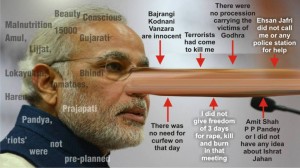Anahita Mukherji | TNN
Gujarat chief minister Narendra Modi has based his pitch for the prime minister’s job on the state’s performance since he has been at its helm, but that theory has been widely disputed. Now Hemantkumar Shah, an economics professor at Gujarat University, has challenged Modi’s claim of dramatic economic growth. He said data reveals the state’s economic and human development parameters worsened under Modi.
In his book ‘Sacchai Gujarat Ki,’ Shah has said Gujarat’s growth rate actually declined during the time that Modi has been in power. “Gujarat’s annual average growth rate (AAGR) was 14.97% during 1980-1990 and 12.77% during 1990-2000, way higher than the national average of 5.5%. Between 2001-11, the AAGR plummeted to 9.82%, only 1.26% more than the national average,” argued Shah.
“While Gujarat’s budget increased from Rs 28,000 crore in 2001 to Rs 1,20,000 crore in 2013-14, public debt during the same period increased from Rs 26,000 crore to Rs 1,68,000 crore,” said Shah. He claimed Modi has hypnotized and mesmerized people into believing in his growth model, and virtually demolished the BJP. “There is no BJP. Modi is the state,” claimed Shah.
Shah, who studied government data, RTI data and international reports, said while there were 26.19 lakh BPL families in Gujarat in 1999, their number is now 40 lakh according to a government ad aired on FM radio in January 2014.
“The UNDP’s multi-dimensional poverty index 2010 shows 41.5% of the state’s population lives in poverty, while CAG reports from 2001-2012/13 show corruption to the tune of Rs 1.5 lakh crore. The state took nine years to appoint a Lok Ayukta,” he added.
As for the controversial Narmada Dam, Shah said sub-canals that should carry water to farms have not been constructed, so water from the dam travels halfway across Gujarat and then ends up in the Arabian Sea.
“Without declaring emergency, Gujarat is in a state of emergency,” said Shah.
GUJARAT MIRAGE MEETS DATA CHECK
Budget & Public Debt
Gujarat’s budget increased from 28,000 crore (2001) to 1,20,000 crore (2013-14)
In the same period, public debt went up from 26,000 crore to 1,68,000 crore, and is now 28,000 per head, the highest for any state. In 2014-15 the public debt is estimated to be at 1,85,000 crore, or 30,000 per head
Capital Inflow
Investment worth 20.8 lakh crore was promised in the ‘Vibrant Gujarat’ summit in 2011, but two years later, it stands at just 1.46% of that amount
Foreign Investment
FDI in 2011-12 was 4,730 crore, but dropped 43% to 2,676 crore in 2012-13
Gujarat ranks 6th in contribution to India’s FDI, after Maharashtra, Tamil Nadu, Delhi, Karnataka and AP
Gujarat’s contribution to the country’s total FDI was 2% while Maharashtra’s was 39%
Human Development Parameters
From 2011-13, CAG reports show corruption to the tune of 1.5 lakh crore in Gujarat. The state did not appoint a Lok Ayukta for nine years
Gujarat ranked 10th in the Planning Commission’s 2001 National Human Development Report, but dropped to 11th in 2011
In 1999, Gujarat had 26.19 lakh BPL families. Now there are 40 lakh, according to a government ad which was aired on FM radio in January 2014
Gujarat ranks 8th in poverty among 20 Indian states according to the Oxford Human Development Initiative (2011)
According to the UNDP’s multidimensional poverty index (2010), 41.5% of Gujarat’s population still lives in poverty
Gujarat has 16 lakh educated unemployed youth according to the state government’s 2012-13 socio-economic survey
There are 47,000 vacancies for teachers in primary and secondary schools
All 30 universities that opened in Gujarat in the last 12 years were in the private sector
Drop-out rate after Class V is 29.5% and 43% before Class X
43% children below 5 years are undernourished
47% women are undernourished
Over 5,500 farmers committed suicide in the state, police were instructed not to register cases


Leave a Reply